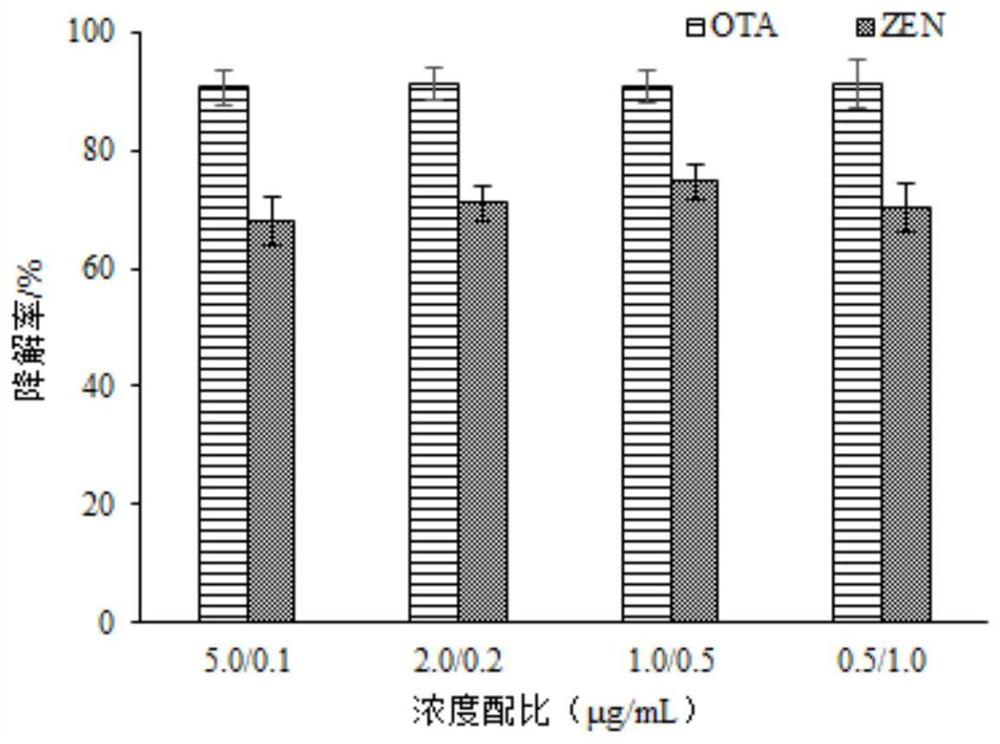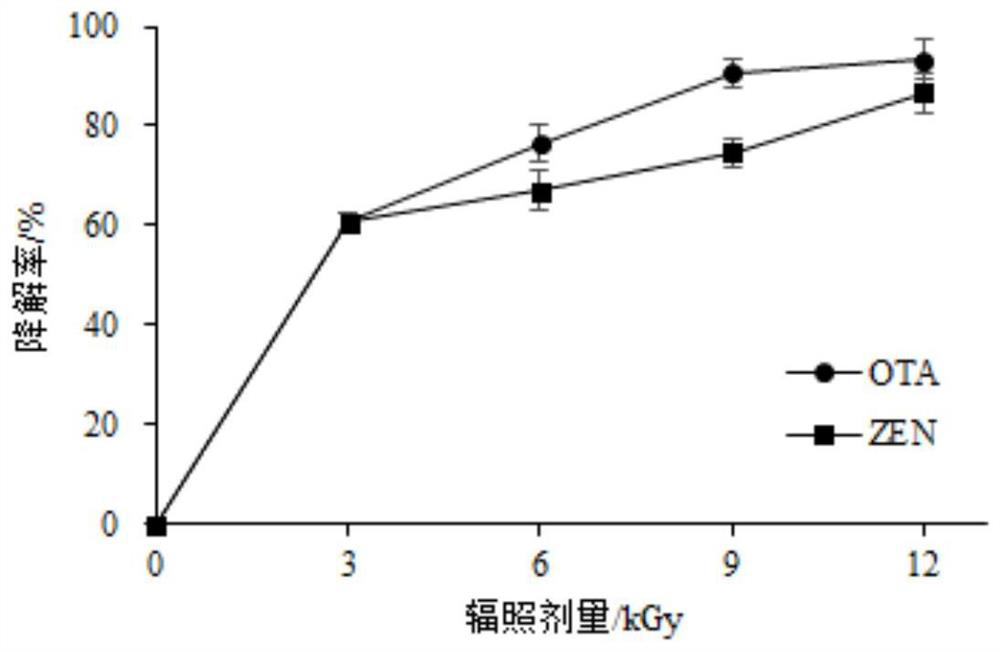A combined degradation method of zearalenone and ochratoxin a in a solution
A technology for zearalenone and ochratoxin, which is applied in the preparation of test samples, instruments, measuring devices, etc., to achieve the effects of remarkable effect, efficient degradation and simple operation
- Summary
- Abstract
- Description
- Claims
- Application Information
AI Technical Summary
Problems solved by technology
Method used
Image
Examples
Embodiment 1
[0020] Example 1, the influence of different concentration ratios on the irradiation effect of ZEN and OTA mixed solution
[0021] At room temperature, a certain amount of ZEN and OTA standard stock solutions were mixed, blown to dryness with nitrogen, and redissolved in acetonitrile to obtain ZEN / OTA concentration ratios of 5.0 / 0.1, 2.0 / 0.2, 1.0 / 0.5 and 0.5 / 1.0μg / mL working solution is irradiated with 9kGy electron beam.
[0022] Result analysis:
[0023] Such as figure 1 As shown, under different concentration ratios, both ZEN and OTA in the working solution have achieved significant degradation effects. The OTA degradation rate is over 90%, and the ZEN degradation rate is also higher than 65%. The concentration ratio is 1.0 / 0.5μg / mL When , the comprehensive degradation effect of ZEN and OTA in the working solution was slightly higher than that of other groups.
Embodiment 2
[0024] Embodiment 2, the influence of different solvents on the irradiation effect of ZEN and OTA mixed solution
[0025] At room temperature, a certain amount of ZEN and OTA standard stock solutions were mixed, blown to dryness with nitrogen, and redissolved in acetonitrile and methanol respectively to obtain a working solution with a ZEN / OTA concentration ratio of 1.0 / 0.5 μg / mL, using 9 kGy electron beam irradiation treatment.
[0026] Result analysis:
[0027] Such as figure 2 As shown, ZEN and OTA in different solvent working solutions have achieved significant degradation results, and in acetonitrile solvent, the degradation rates of OTA and ZEN are as high as 90.61% and 74.67%. The reason is that methanol is a hole-scavenging agent, which can capture hydroxyl radicals and hydrated electrons, and has a certain inhibitory effect on the degradation of toxins. Acetonitrile solvents are irradiated at this dose to produce a certain amount of free radicals, which participate...
Embodiment 3
[0028] Embodiment 3, the impact of different irradiation doses on the irradiation effect of ZEN and OTA mixed solution
[0029] At room temperature, take a certain amount of ZEN and OTA standard stock solutions and mix them respectively. After nitrogen blowing to dryness, use acetonitrile to redissolve to obtain a working solution with a ZEN / OTA concentration ratio of 1.0 / 0.5 μg / mL. Use 3-12 kGy Electron beam irradiation treatment.
[0030] Result analysis:
[0031] Such as image 3 As shown, at a dose of 3kGy, the degradation rates of ZEN and OTA are basically the same, and as the irradiation dose increases, the degradation rate of OTA is gradually higher than that of ZEN. 86.70%. The reason is that the molecular structure of OTA contains relatively more polar sites, which is easy to be degraded by electron beam irradiation. After 9kGy, the degradation rate of ZEN shows a certain increase. The reason is that at a higher irradiation dose, acetonitrile produces free radicals...
PUM
 Login to View More
Login to View More Abstract
Description
Claims
Application Information
 Login to View More
Login to View More - R&D
- Intellectual Property
- Life Sciences
- Materials
- Tech Scout
- Unparalleled Data Quality
- Higher Quality Content
- 60% Fewer Hallucinations
Browse by: Latest US Patents, China's latest patents, Technical Efficacy Thesaurus, Application Domain, Technology Topic, Popular Technical Reports.
© 2025 PatSnap. All rights reserved.Legal|Privacy policy|Modern Slavery Act Transparency Statement|Sitemap|About US| Contact US: help@patsnap.com



